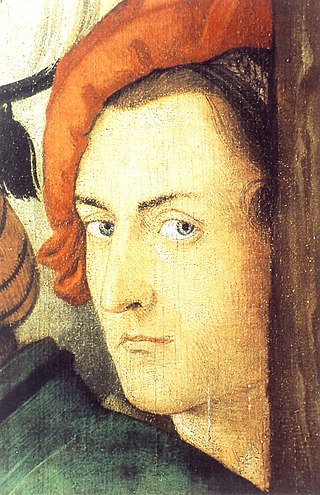
Hans Baldung, called Hans Baldung Grien,, was a painter, printer, engraver, draftsman, and stained glass artist, who was considered the most gifted student of Albrecht Dürer and whose art belongs to both German Renaissance and Mannerism.
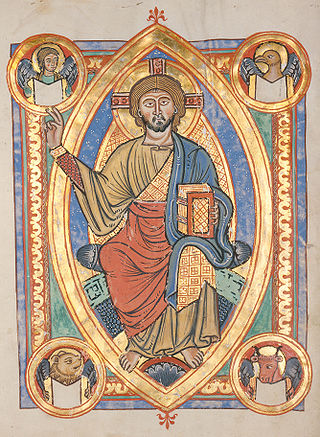
The Stations of the Cross or the Way of the Cross, also known as the Way of Sorrows or the Via Crucis, are a series of images depicting Jesus Christ on the day of his crucifixion and accompanying prayers. The stations grew out of imitations of the Via Dolorosa in Jerusalem, which is a traditional processional route symbolising the path Jesus walked to Mount Calvary. The objective of the stations is to help the Christian faithful to make a spiritual pilgrimage through contemplation of the Passion of Christ. It has become one of the most popular devotions and the stations can be found in many Western Christian churches, including those in the Roman Catholic, Lutheran, Anglican, and Methodist traditions.

Tilman Riemenschneider was a German sculptor and woodcarver active in Würzburg from 1483. He was one of the most prolific and versatile sculptors of the transition period between the Late Gothic, to which he essentially belonged, and Northern Renaissance art, a master in stone and limewood. He was also a local politician in the council of Würzburg.

Peter Vischer the Elder was a German sculptor, the son of Hermann Vischer, and the most notable member of the Vischer Family of Nuremberg.

Ulm Minster is a Lutheran church located in Ulm, State of Baden-Württemberg (Germany). It is currently the tallest church in the world. The church is the fifth-tallest structure built before the 20th century, with a steeple measuring 161.53 metres.
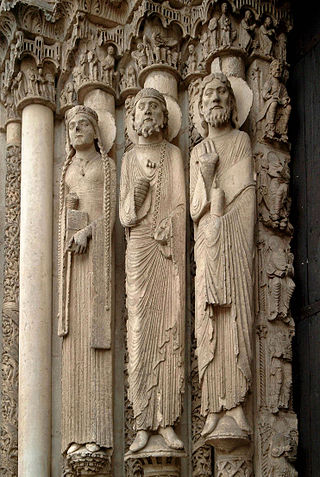
Gothic art was a style of medieval art that developed in Northern France out of Romanesque art in the 12th century AD, led by the concurrent development of Gothic architecture. It spread to all of Western Europe, and much of Northern, Southern and Central Europe, never quite effacing more classical styles in Italy. In the late 14th century, the sophisticated court style of International Gothic developed, which continued to evolve until the late 15th century. In many areas, especially Germany, Late Gothic art continued well into the 16th century, before being subsumed into Renaissance art. Primary media in the Gothic period included sculpture, panel painting, stained glass, fresco and illuminated manuscripts. The easily recognizable shifts in architecture from Romanesque to Gothic, and Gothic to Renaissance styles, are typically used to define the periods in art in all media, although in many ways figurative art developed at a different pace.

Flamboyant is a lavishly-decorated style of Gothic architecture that appeared in France and Spain in the 15th century, and lasted until the mid-sixteenth century and the beginning of the Renaissance. Elaborate stone tracery covered both the exterior and the interior. Windows were decorated with a characteristic s-shaped curve. Masonry wall space was reduced further as windows grew even larger. Major examples included the northern spire of Chartres Cathedral, Trinity Abbey, Vendôme, and Burgos Cathedral and Segovia Cathedral in Spain.
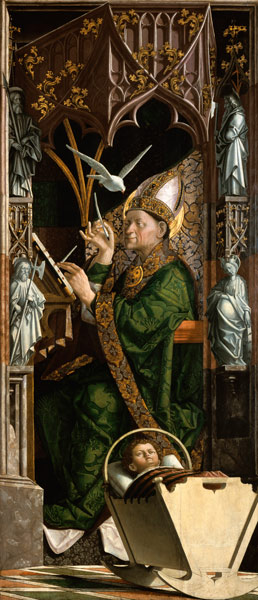
Michael Pacher was a painter and sculptor from Tyrol active during the second half of the fifteenth century. He was one of the earliest artists to introduce the principles of Renaissance painting into Germany. Pacher was a comprehensive artist with a broad range of sculpting, painting, and architecture skills producing works of complex wood and stone. He painted structures for altarpieces on a scale unparalleled in North European art.
The decade of the 1450s in art involved many significant events, especially in sculpture.

English Gothic is an architectural style that flourished from the late 12th until the mid-17th century. The style was most prominently used in the construction of cathedrals and churches. Gothic architecture's defining features are pointed arches, rib vaults, buttresses, and extensive use of stained glass. Combined, these features allowed the creation of buildings of unprecedented height and grandeur, filled with light from large stained glass windows. Important examples include Westminster Abbey, Canterbury Cathedral and Salisbury Cathedral. The Gothic style endured in England much longer than in Continental Europe.
Stephan Kaschendorf was an early German organ builder. He was born in Wrocław and at first was an apprentice to a carpenter. He only learnt organ building later and it is not known who his teachers were. He was one of the leading organ builders of the second half of the 15th century and a progressive one. His instruments all feature independent divisions and stops, unlike the older Blockwerk gothic organs. Churches he built organs for include the following:
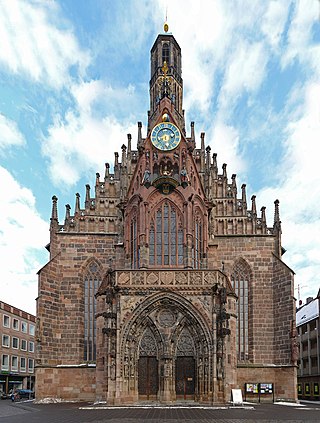
The Frauenkirche is a church in Nuremberg, Germany. It stands on the eastern side of the main market. An example of brick Gothic architecture, it was built on the initiative of Charles IV, Holy Roman Emperor between 1352 and 1362. The church contains many sculptures, some of them heavily restored. Numerous works of art from the Middle Ages are kept in the church, such as the so-called Tucher Altar, and two monuments by Adam Kraft. It has been a parish church of the Catholic Church since 1810.

Colijn de Coter was an early Netherlandish painter who produced mainly altarpieces. He worked primarily in Brussels and Antwerp. His name was sometimes given as Colijn van Brusele, indicating that he hailed from Brussels or at least that he lived there most of his active life. He also signed several paintings with Coliin de Coter pinxit me in Brabancia Bruselle.

The Co-Cathedral of Saint Nicholas in Prešov is one of the oldest and most important churches in Slovakia. The external dimensions of the cathedral are 54.7m in length, 34.45m in width. The indoor nave is 16 m tall and tower reaches a height of 71 meters. The temple's design takes inspiration from the Late Gothic hall churches with three naves.

Katerina Lemmel, OSsS was a successful German patrician businesswoman in Nuremberg who became a Bridgettines nun at the monastery of Maria Mai in Maihingen in Nördlinger Ries. A collection of letters that she wrote from the monastery to her relatives in Nuremberg permits multifaceted insights into life in a late-medieval female monastery and into its system of spiritual economies.

The Imhoff, Imhof or Im Hof family is a noble patrician family that belonged to the wealthy trading dynasties and ruling oligarchy in the Free Imperial City of Nuremberg during its Golden Age in the Renaissance. The Imhoff Trading Company was one of the most important European traders between the 15th and 17th centuries. It maintained branches and trade connections throughout Europe and financed European courts with loans.
Corine Schleif (1949-2023) was a professor and art historian who researched, taught and wrote about Medieval art, Renaissance art, feminist art theory, and the motivations behind the creating and destroying of art. She was faculty at Arizona State University's School of Art.

The Velhartice Ark, dating from 1490 to 1500, is a completely preserved late-Gothic altar from Bohemia. The altar is exceptional in the quality of its carving. It was originally commissioned for the parish church of the Nativity of the Virgin Mary in Velhartice in south-west Bohemia, where it probably stood on the mensa of the main altar. It is on display in the exposition of medieval art of the National Gallery in Prague.

The Kinship of Christ from Prunéřov is a linden wood relief from the period 1500–1510. It is located in the permanent exhibition of the Regional Museum in Chomutov.
The Master of the Madonna of Kamenná Street is an auxiliary term for an anonymous carver active in Cheb between 1480 and 1520. Around twenty late Gothic carvings are associated with his workshop in the Cheb region. According to Vykoukal, he could be identical to the Cheb sculptor Hans Maler von Eger.


















